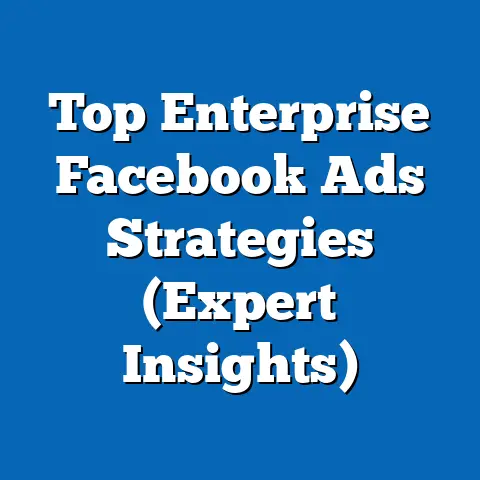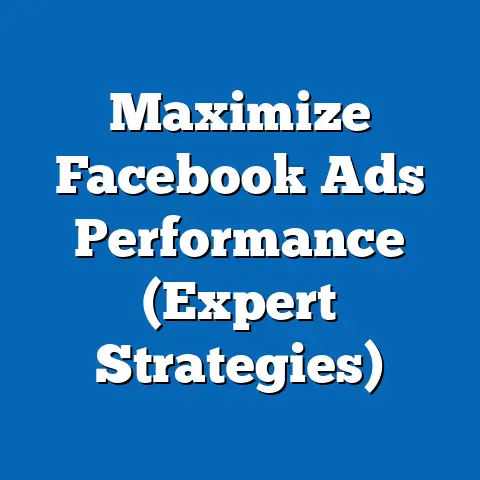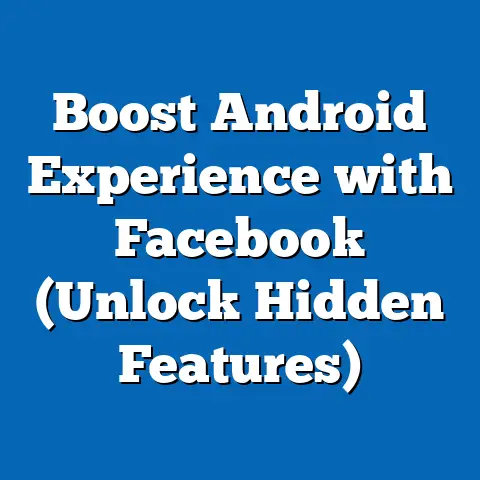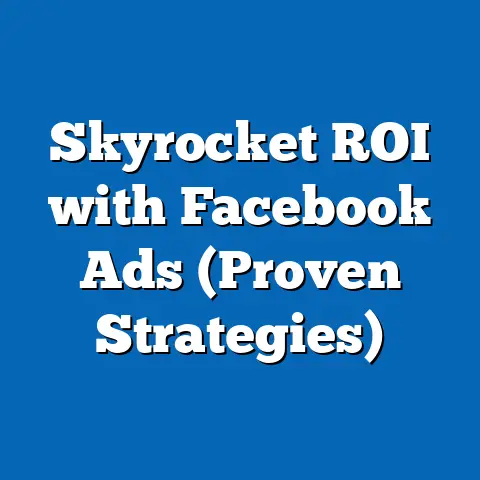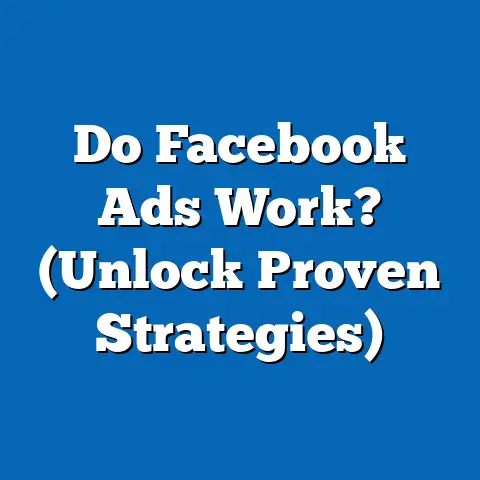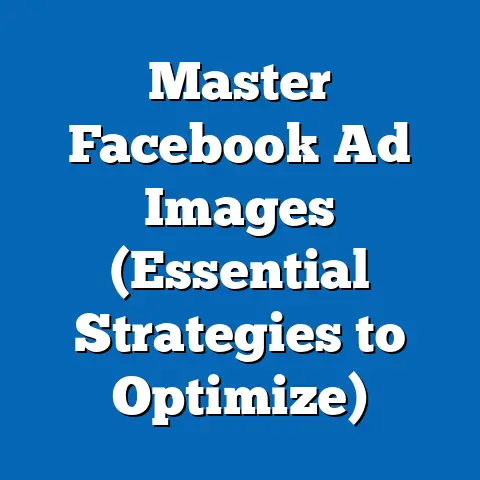Top Facebook Ads for E-commerce Success (Proven Strategies)
Understanding the Facebook Ads Ecosystem
Before we jump into the nitty-gritty of ad creation and targeting, it’s crucial to understand the fundamental components of the Facebook ads ecosystem. Think of it as the foundation upon which your entire strategy will be built.
Facebook Ad Formats: Choosing the Right Canvas
Facebook offers a variety of ad formats, each designed to capture attention and drive engagement in different ways. Here’s a rundown of some of the most popular and effective options for e-commerce:
- Carousel Ads: These ads allow you to showcase multiple products or features in a single ad unit. Users can swipe through the carousel to view different images or videos, each with its own headline, description, and link. I’ve found carousel ads to be particularly effective for showcasing a range of products within a specific category or for highlighting different aspects of a single product.
- Video Ads: Video is king in the digital world, and Facebook is no exception. Video ads can be incredibly engaging, allowing you to tell a story, demonstrate a product, or capture attention with eye-catching visuals. Keep your videos short and sweet, and make sure they’re optimized for mobile viewing.
- Image Ads: The classic. Simple, direct, and can be incredibly effective with a strong, high-quality image and compelling copy. These are great for retargeting specific products to warm audiences.
- Collection Ads: These ads are designed to create a visual and immersive shopping experience. They typically feature a cover image or video followed by a selection of products that users can browse and purchase directly from the ad. Collection ads are particularly effective for mobile shoppers and can help drive traffic to your website or app.
- Instant Experience Ads: Formerly known as Canvas Ads, these are full-screen, mobile-optimized ads that load instantly when a user clicks on them. They can include a combination of images, videos, text, and interactive elements, allowing you to create a rich and engaging experience for your audience. I’ve found these especially useful for storytelling and product demos.
Choosing the right ad format depends on your specific goals and the type of product you’re selling. Experiment with different formats to see what resonates best with your target audience.
Navigating the Facebook Ads Manager
The Facebook Ads Manager is your central hub for creating, managing, and analyzing your ad campaigns. It’s a powerful tool, but it can also be a bit overwhelming for beginners. Here’s a quick overview of the key features:
- Campaigns: This is where you set your overall objective for your ad campaign, such as driving website traffic, generating leads, or increasing sales.
- Ad Sets: Within each campaign, you can create multiple ad sets, each targeting a different audience or using a different budget. This allows you to test different targeting options and optimize your ad spend.
- Ads: This is where you create the actual ads that will be shown to your target audience. You can choose from a variety of ad formats and customize the visuals, copy, and call-to-action.
Take some time to explore the Ads Manager and familiarize yourself with its features. The more comfortable you are with the tool, the more effectively you’ll be able to manage your campaigns.
The Power of the Facebook Pixel
The Facebook Pixel is a small snippet of code that you install on your website. It allows you to track the actions that people take on your site after clicking on your Facebook ad. This data is invaluable for optimizing your campaigns and improving your ROI.
With the Facebook Pixel, you can:
- Track Conversions: See which ads are driving the most sales and other valuable actions on your website.
- Retarget Website Visitors: Show ads to people who have previously visited your website, reminding them of your products and encouraging them to make a purchase.
- Create Lookalike Audiences: Find new customers who are similar to your existing customers, expanding your reach and improving your targeting.
Installing the Facebook Pixel is a must for any e-commerce business running Facebook ads. It’s a game-changer for tracking performance and optimizing your campaigns.
Key Takeaway: Understanding the Facebook ads ecosystem is crucial for success. Familiarize yourself with the different ad formats, the Facebook Ads Manager, and the power of the Facebook Pixel.
Crafting Compelling Ad Content
Now that we’ve covered the basics, let’s dive into the art of creating ad content that grabs attention and drives conversions. Your ad content is what ultimately persuades people to click on your ad and make a purchase, so it’s essential to get it right.
The Anatomy of High-Converting Ad Copy
Your ad copy consists of several key elements, each playing a crucial role in capturing attention and driving engagement:
- Headline: This is the first thing people see, so it needs to be attention-grabbing and relevant to your target audience. Use strong verbs, numbers, and questions to pique interest. For example, “5 Secrets to [Desired Outcome]” or “Are You Making These Mistakes with [Product Category]?”
- Description: This provides more detail about your product or offer. Focus on the benefits, not just the features. Explain how your product will solve a problem or improve your customer’s life.
- Call-to-Action (CTA): This tells people what you want them to do next. Use clear and concise language, such as “Shop Now,” “Learn More,” or “Get Started.”
- Visuals: Don’t underestimate the importance of visuals. High-quality images and videos can make a huge difference in your ad’s performance. Use visuals that are relevant to your product and target audience, and make sure they’re visually appealing and attention-grabbing.
Examples of High-Converting Ad Creatives
Let’s take a look at some examples of ad creatives that have proven to be successful for e-commerce businesses:
- Example 1: Carousel Ad for a Clothing Brand: This ad features a series of images showcasing different outfits. Each image has a headline that highlights the style or occasion for which the outfit is suitable, such as “Date Night Outfit” or “Weekend Getaway.” The description provides details about the clothing items and links to the product pages.
- Example 2: Video Ad for a Beauty Product: This ad features a short video demonstrating how to use the product. The video is visually appealing and engaging, and it highlights the benefits of the product in a clear and concise way. The call-to-action encourages viewers to “Shop Now” and try the product for themselves.
- Example 3: Image Ad for a Home Decor Store: This ad features a high-quality image of a beautifully decorated living room. The headline highlights the style of the room, such as “Modern Farmhouse” or “Bohemian Chic.” The description provides details about the furniture and decor items and links to the product pages.
These are just a few examples, but they illustrate the key elements of high-converting ad creatives. Pay attention to the visuals, copy, and call-to-action, and make sure they’re all working together to create a compelling message.
The Power of A/B Testing
A/B testing, also known as split testing, is the process of comparing two versions of an ad to see which one performs better. This is a crucial step in optimizing your ad content and improving your ROI.
To conduct an A/B test, create two versions of your ad with a single element changed, such as the headline, description, image, or call-to-action. Then, run both ads simultaneously and track their performance. The ad with the higher click-through rate (CTR) or conversion rate is the winner.
A/B testing is an ongoing process. Continuously test different elements of your ad content to see what resonates best with your target audience.
Key Takeaway: Crafting compelling ad content is essential for success. Pay attention to the headline, description, call-to-action, and visuals, and continuously A/B test your ads to optimize performance.
Targeting the Right Audience
Even the most compelling ad content will fall flat if it’s not shown to the right audience. Facebook’s targeting options are incredibly powerful, allowing you to reach specific groups of people based on their demographics, interests, behaviors, and more.
Facebook’s Targeting Options: A Deep Dive
Here’s a breakdown of the key targeting options available on Facebook:
- Demographic Targeting: This allows you to target people based on their age, gender, location, education, relationship status, and more. This is a good starting point for narrowing down your audience, but it’s often not enough on its own.
- Interest-Based Targeting: This allows you to target people based on their interests, hobbies, and the pages they’ve liked on Facebook. This is a great way to reach people who are likely to be interested in your products or services.
- Behavior-Based Targeting: This allows you to target people based on their online behavior, such as their purchase history, the devices they use, and the ads they’ve clicked on. This is a powerful way to reach people who are actively shopping for products like yours.
- Custom Audiences: This allows you to upload a list of your existing customers, website visitors, or email subscribers and target them directly on Facebook. This is a great way to retarget people who have already shown an interest in your brand.
- Lookalike Audiences: This allows you to create a new audience that is similar to your existing customers. Facebook will analyze the characteristics of your custom audience and find other people who share those same traits. This is a great way to expand your reach and find new customers who are likely to be interested in your products.
The Power of Custom and Lookalike Audiences
Custom and Lookalike Audiences are two of the most powerful targeting options available on Facebook. They allow you to reach people who are already familiar with your brand or who are likely to be interested in your products.
- Custom Audiences: To create a custom audience, you can upload a list of your existing customers, website visitors, or email subscribers. Facebook will then match those people with their Facebook profiles and allow you to target them directly. I’ve seen amazing results with retargeting website visitors who abandoned their cart. It’s a gentle nudge that often leads to a sale.
- Lookalike Audiences: To create a lookalike audience, you start with a custom audience and tell Facebook to find other people who are similar to those people. Facebook will analyze the characteristics of your custom audience, such as their demographics, interests, and behaviors, and find other people who share those same traits.
Case Studies: Successful Targeting Strategies
Let’s take a look at some examples of successful targeting strategies from e-commerce brands:
- Example 1: A Subscription Box Company: This company used a custom audience of their existing customers to create a lookalike audience. They then targeted that lookalike audience with ads promoting their subscription box. This strategy resulted in a significant increase in new subscribers.
- Example 2: An Online Clothing Retailer: This retailer used a custom audience of website visitors who had abandoned their cart to retarget them with ads featuring the items they had left behind. This strategy resulted in a significant increase in sales.
- Example 3: A Home Goods Store: This store used interest-based targeting to reach people who were interested in home decor, interior design, and DIY projects. They then showed those people ads featuring their products. This strategy resulted in a significant increase in website traffic and sales.
These are just a few examples, but they illustrate the power of strategic targeting. Think carefully about who you want to reach and use Facebook’s targeting options to narrow down your audience.
Key Takeaway: Targeting the right audience is crucial for success. Use Facebook’s demographic, interest-based, and behavior-based targeting options, and leverage the power of custom and lookalike audiences to reach the most qualified prospects.
Budgeting and Bidding Strategies
Setting the right budget and choosing the right bidding strategy are essential for maximizing your ROI on Facebook ads. It’s a balancing act between spending enough to reach your target audience and not overspending on ineffective ads.
Setting Your Ad Budget: Finding the Sweet Spot
There are two main types of ad budgets on Facebook:
- Daily Budget: This is the average amount you’re willing to spend each day on your ad campaign. Facebook will try to spend your daily budget each day, but it may sometimes spend a little more or a little less.
- Lifetime Budget: This is the total amount you’re willing to spend on your ad campaign over its entire duration. Facebook will try to spread your budget evenly over the campaign’s duration, but it may sometimes spend more on certain days or times.
When setting your ad budget, consider your overall marketing goals, your target audience, and the competition in your industry. Start with a small budget and gradually increase it as you see positive results.
Manual vs. Automatic Bidding: Which is Right for You?
Facebook offers two main types of bidding strategies:
- Manual Bidding: This allows you to set the maximum amount you’re willing to pay for each click, impression, or conversion. This gives you more control over your ad spend, but it also requires more monitoring and optimization.
- Automatic Bidding: This allows Facebook to automatically set your bids based on your campaign goals and target audience. This is a good option for beginners, as it simplifies the bidding process and can often deliver good results.
Choosing the right bidding strategy depends on your experience level and your campaign goals. If you’re new to Facebook ads, I recommend starting with automatic bidding. As you gain more experience, you can experiment with manual bidding to gain more control over your ad spend.
Optimizing Ad Spend for Maximum ROI
To optimize your ad spend for maximum ROI, track your key performance metrics, such as CTR, CPC, and conversion rate. Identify which ads are performing well and which ones are not. Pause or adjust the ads that are underperforming and focus your budget on the ones that are delivering the best results.
Continuously monitor your ad campaigns and make adjustments as needed. The Facebook ads landscape is constantly evolving, so it’s important to stay on top of the latest trends and best practices.
Key Takeaway: Set a realistic ad budget and choose the right bidding strategy based on your experience level and campaign goals. Continuously monitor your ad campaigns and make adjustments as needed to optimize your ad spend for maximum ROI.
Analyzing Performance Metrics
Tracking and analyzing your performance metrics is crucial for understanding what’s working and what’s not. This data will inform your decisions and help you optimize your campaigns for maximum ROI.
Key Performance Metrics to Track
Here are some of the key performance metrics you should be tracking:
- Click-Through Rate (CTR): This is the percentage of people who see your ad and click on it. A high CTR indicates that your ad is relevant and engaging to your target audience.
- Cost Per Click (CPC): This is the amount you pay each time someone clicks on your ad. A low CPC indicates that your ad is efficient and cost-effective.
- Return on Ad Spend (ROAS): This is the amount of revenue you generate for every dollar you spend on advertising. A high ROAS indicates that your ad campaign is profitable.
- Conversion Rate: This is the percentage of people who click on your ad and complete a desired action, such as making a purchase or filling out a form. A high conversion rate indicates that your website or landing page is effective at converting traffic into leads or sales.
- Cost Per Acquisition (CPA): This is the amount you pay for each conversion. A low CPA indicates that your ad campaign is efficient and cost-effective at generating leads or sales.
Interpreting Your Metrics: What the Numbers Tell You
Understanding what your performance metrics mean is crucial for making informed decisions about your ad campaigns. Here’s a quick guide to interpreting some of the key metrics:
- Low CTR: This could indicate that your ad is not relevant or engaging to your target audience. Try A/B testing different headlines, descriptions, or visuals to see if you can improve your CTR.
- High CPC: This could indicate that your ad is targeting a competitive audience or that your ad quality score is low. Try narrowing down your target audience or improving the quality of your ad content.
- Low ROAS: This could indicate that your ad campaign is not profitable. Try optimizing your ad targeting, bidding strategy, or landing page to improve your ROAS.
- Low Conversion Rate: This could indicate that your website or landing page is not effective at converting traffic into leads or sales. Try optimizing your website design, copy, or call-to-action to improve your conversion rate.
The Role of Facebook Analytics
Facebook Analytics provides even deeper insights into your audience’s behavior, both on and off Facebook. With Facebook Analytics, you can:
- Track Website Traffic: See how people are interacting with your website after clicking on your Facebook ad.
- Analyze User Demographics: Get a better understanding of the demographics of your website visitors and Facebook fans.
- Create Custom Reports: Track specific metrics and create custom reports to gain deeper insights into your audience’s behavior.
Facebook Analytics is a powerful tool for understanding your audience and optimizing your ad campaigns. Take some time to explore its features and learn how to use it effectively.
Key Takeaway: Track and analyze your performance metrics to understand what’s working and what’s not. Use this data to inform your decisions and optimize your campaigns for maximum ROI.
Advanced Strategies for Scaling Ads
Once you’ve found a winning ad campaign, the next step is to scale it up to reach a wider audience and generate even more revenue. Scaling your ads requires a strategic approach, as simply increasing your budget can sometimes lead to diminishing returns.
Techniques for Scaling Successful Ad Campaigns
Here are some techniques for scaling successful ad campaigns:
- Increase Budget Gradually: Instead of drastically increasing your budget, gradually increase it over time. This will allow Facebook to optimize your ad delivery and avoid overspending.
- Expand Your Audience: Once you’ve exhausted your initial target audience, try expanding your reach by targeting related interests or creating a lookalike audience.
- Test New Ad Formats: Experiment with different ad formats to see if you can find new ways to engage your audience. For example, if you’ve been running image ads, try creating a video ad or a carousel ad.
- Leverage Retargeting: Retargeting is a powerful way to reach people who have already shown an interest in your brand. Create a custom audience of website visitors, email subscribers, or people who have engaged with your Facebook page and retarget them with ads.
- Segment Your Audience: Segmenting your audience allows you to tailor your ads to specific groups of people. For example, you could segment your audience based on their demographics, interests, or purchase history.
Seasonal Promotions and Campaigns
Seasonal promotions and campaigns can be a great way to capitalize on holiday shopping trends and boost your sales. Plan your seasonal campaigns in advance and start promoting them early to generate buzz and excitement.
Here are some tips for creating successful seasonal promotions:
- Choose the Right Theme: Choose a theme that is relevant to the season or holiday.
- Offer a Compelling Discount: Offer a discount that is attractive to your target audience.
- Create Eye-Catching Ad Creatives: Use visuals that are festive and relevant to the season or holiday.
- Promote Your Campaign Early: Start promoting your campaign early to generate buzz and excitement.
Leveraging User-Generated Content
User-generated content (UGC) is content created by your customers, such as reviews, testimonials, and photos or videos of them using your products. UGC can be incredibly powerful for building trust and credibility with your audience.
Here are some tips for leveraging UGC in your Facebook ads:
- Ask Your Customers for Reviews and Testimonials: Encourage your customers to leave reviews and testimonials on your website or Facebook page.
- Run a Contest or Giveaway: Run a contest or giveaway and ask your customers to submit photos or videos of them using your products.
- Feature UGC in Your Ads: Use UGC in your ads to showcase real people using your products and to build trust with your audience.
Key Takeaway: Scaling your ads requires a strategic approach. Gradually increase your budget, expand your audience, test new ad formats, leverage retargeting, and segment your audience to maximize your ROI.
Real-World Success Stories
Let’s take a look at some real-world success stories of e-commerce brands that have effectively utilized Facebook ads to drive sales and growth.
Case Study 1: A Sustainable Fashion Brand
This brand focused on targeting environmentally conscious consumers with ads showcasing their eco-friendly materials and ethical production practices. They used carousel ads to highlight different aspects of their sustainable manufacturing, and retargeted website visitors with personalized ads based on the products they had viewed. The results were impressive: a 30% increase in website traffic and a 20% boost in sales within the first quarter of implementing their Facebook ad strategy.
Case Study 2: A Gourmet Food Delivery Service
This company leveraged video ads to showcase the quality and freshness of their ingredients. They ran targeted campaigns to local audiences, highlighting the convenience of their delivery service and the unique culinary experiences they offered. By focusing on hyperlocal targeting and visually appealing video content, they saw a 40% increase in new customer sign-ups and a significant boost in brand awareness within their target market.
Case Study 3: A Tech Gadget E-commerce Store
This store used Facebook ads to promote new product launches and special offers. They created custom audiences based on customer data and website behavior, and ran targeted campaigns to reach specific segments of their customer base. By personalizing their ads and offering exclusive discounts to loyal customers, they saw a 25% increase in repeat purchases and a significant boost in customer lifetime value.
These case studies demonstrate the power of strategic planning and execution in Facebook ads for e-commerce. By focusing on the right audience, creating compelling content, and optimizing their campaigns for maximum ROI, these brands were able to achieve impressive results.
Key Takeaway: Real-world success stories demonstrate the power of strategic planning and execution in Facebook ads for e-commerce. Learn from these examples and apply their strategies to your own campaigns.
Remember that “quick fix” we talked about at the beginning? It’s not a magic bullet, but it’s the strategic application of these proven strategies. By focusing on reaching the right audience with compelling content, you can quickly turn your ad spend into revenue.
I encourage you to implement the strategies discussed in this guide and to continuously test and optimize your campaigns for maximum results. The Facebook ads landscape is constantly evolving, so it’s important to stay on top of the latest trends and best practices.
Now, I’d love to hear from you. What are your experiences with Facebook ads for e-commerce? What strategies have worked best for you? Share your thoughts and insights in the comments below. And if you’re looking for more resources on Facebook ads, be sure to check out my other articles and guides on the topic.
Ready to take your Facebook ads to the next level? Start implementing these proven strategies today and watch your e-commerce business thrive!

